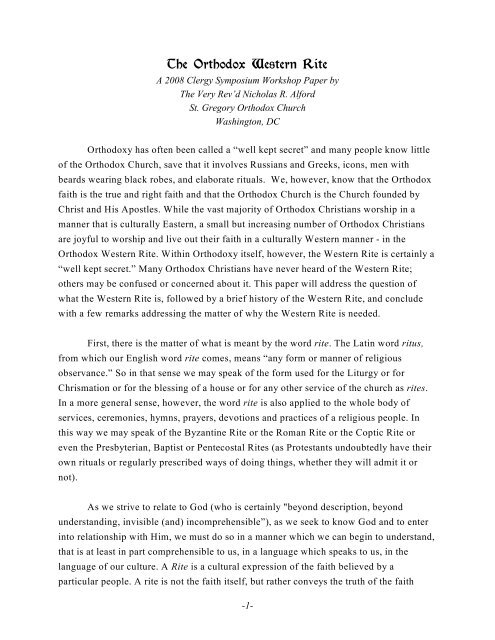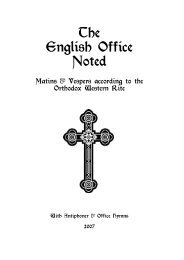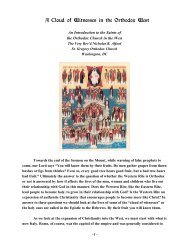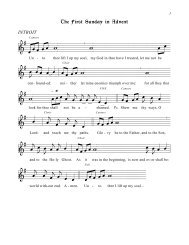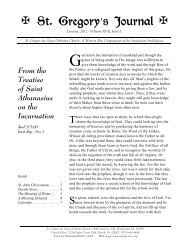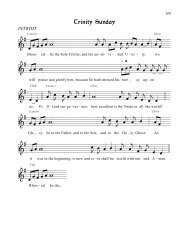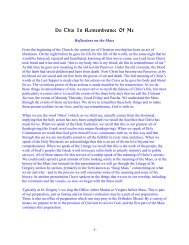The Orthodox Western Rite - St. Gregory the Great Orthodox Church
The Orthodox Western Rite - St. Gregory the Great Orthodox Church
The Orthodox Western Rite - St. Gregory the Great Orthodox Church
Create successful ePaper yourself
Turn your PDF publications into a flip-book with our unique Google optimized e-Paper software.
<strong>The</strong> <strong>Orthodox</strong> <strong>Western</strong> <strong>Rite</strong><br />
A 2008 Clergy Symposium Workshop Paper by<br />
<strong>The</strong> Very Rev’d Nicholas R. Alford<br />
<strong>St</strong>. <strong>Gregory</strong> <strong>Orthodox</strong> <strong>Church</strong><br />
Washington, DC<br />
<strong>Orthodox</strong>y has often been called a “well kept secret” and many people know little<br />
of <strong>the</strong> <strong>Orthodox</strong> <strong>Church</strong>, save that it involves Russians and Greeks, icons, men with<br />
beards wearing black robes, and elaborate rituals. We, however, know that <strong>the</strong> <strong>Orthodox</strong><br />
faith is <strong>the</strong> true and right faith and that <strong>the</strong> <strong>Orthodox</strong> <strong>Church</strong> is <strong>the</strong> <strong>Church</strong> founded by<br />
Christ and His Apostles. While <strong>the</strong> vast majority of <strong>Orthodox</strong> Christians worship in a<br />
manner that is culturally Eastern, a small but increasing number of <strong>Orthodox</strong> Christians<br />
are joyful to worship and live out <strong>the</strong>ir faith in a culturally <strong>Western</strong> manner - in <strong>the</strong><br />
<strong>Orthodox</strong> <strong>Western</strong> <strong>Rite</strong>. Within <strong>Orthodox</strong>y itself, however, <strong>the</strong> <strong>Western</strong> <strong>Rite</strong> is certainly a<br />
“well kept secret.” Many <strong>Orthodox</strong> Christians have never heard of <strong>the</strong> <strong>Western</strong> <strong>Rite</strong>;<br />
o<strong>the</strong>rs may be confused or concerned about it. This paper will address <strong>the</strong> question of<br />
what <strong>the</strong> <strong>Western</strong> <strong>Rite</strong> is, followed by a brief history of <strong>the</strong> <strong>Western</strong> <strong>Rite</strong>, and conclude<br />
with a few remarks addressing <strong>the</strong> matter of why <strong>the</strong> <strong>Western</strong> <strong>Rite</strong> is needed.<br />
First, <strong>the</strong>re is <strong>the</strong> matter of what is meant by <strong>the</strong> word rite. <strong>The</strong> Latin word ritus,<br />
from which our English word rite comes, means “any form or manner of religious<br />
observance.” So in that sense we may speak of <strong>the</strong> form used for <strong>the</strong> Liturgy or for<br />
Chrismation or for <strong>the</strong> blessing of a house or for any o<strong>the</strong>r service of <strong>the</strong> church as rites.<br />
In a more general sense, however, <strong>the</strong> word rite is also applied to <strong>the</strong> whole body of<br />
services, ceremonies, hymns, prayers, devotions and practices of a religious people. In<br />
this way we may speak of <strong>the</strong> Byzantine <strong>Rite</strong> or <strong>the</strong> Roman <strong>Rite</strong> or <strong>the</strong> Coptic <strong>Rite</strong> or<br />
even <strong>the</strong> Presbyterian, Baptist or Pentecostal <strong>Rite</strong>s (as Protestants undoubtedly have <strong>the</strong>ir<br />
own rituals or regularly prescribed ways of doing things, whe<strong>the</strong>r <strong>the</strong>y will admit it or<br />
not).<br />
As we strive to relate to God (who is certainly "beyond description, beyond<br />
understanding, invisible (and) incomprehensible”), as we seek to know God and to enter<br />
into relationship with Him, we must do so in a manner which we can begin to understand,<br />
that is at least in part comprehensible to us, in a language which speaks to us, in <strong>the</strong><br />
language of our culture. A <strong>Rite</strong> is a cultural expression of <strong>the</strong> faith believed by a<br />
particular people. A rite is not <strong>the</strong> faith itself, but ra<strong>the</strong>r conveys <strong>the</strong> truth of <strong>the</strong> faith<br />
-1-
within <strong>the</strong> language of <strong>the</strong> culture, in <strong>the</strong> language of <strong>the</strong> people. His Beatitude<br />
Archbishop Anastasios of Tirana and All Albania has stated:<br />
This issue of culture is a very basic one. When <strong>the</strong> Gospel meets ano<strong>the</strong>r culture, three<br />
things happen. One part of <strong>the</strong> culture clearly you have to accept - for instance, <strong>the</strong><br />
language. Ano<strong>the</strong>r part of <strong>the</strong> culture you have to reject - that which does not agree with<br />
<strong>the</strong> Gospel... and <strong>the</strong>re is a third part, which you have to transform. I can say to “baptize,”<br />
to use it, giving it ano<strong>the</strong>r meaning... We have to see that o<strong>the</strong>r cultures have <strong>the</strong>ir own<br />
dignity, <strong>the</strong>ir own interest and we must respect <strong>the</strong>m... we have to accept our ignorance<br />
and be more humble in our attitude towards o<strong>the</strong>rs. We must accept <strong>the</strong> expression of<br />
<strong>the</strong>ir feelings and <strong>the</strong>ir life and not say, “this is not <strong>Orthodox</strong>!” What is not <strong>Orthodox</strong><br />
Not <strong>Orthodox</strong> is to be impure, to be dishonest, to be against <strong>the</strong> will of God, this is<br />
unorthodox.”<br />
We know that <strong>the</strong> <strong>Orthodox</strong> <strong>Church</strong> is <strong>the</strong> One Holy Catholic and Apostolic<br />
<strong>Church</strong>, <strong>the</strong> <strong>Church</strong> established by Christ and led by <strong>the</strong> Holy Spirit into all truth. For <strong>the</strong><br />
first thousand years after <strong>the</strong> earthly life, death and resurrection of Christ, <strong>the</strong>re was<br />
essentially one <strong>Church</strong> believing a common faith (yes, we can speak of <strong>the</strong> schisms<br />
following <strong>the</strong> Councils of Ephesus and Chalcedon - but <strong>the</strong> East and <strong>the</strong> West were still<br />
united). <strong>The</strong>re was one church united in faith, but with different cultural expressions of<br />
that common faith. In Syria <strong>the</strong> Liturgy of <strong>St</strong>. James was used, in Egypt <strong>the</strong> liturgy of <strong>St</strong>.<br />
Mark, in Rome <strong>the</strong> Liturgy of <strong>St</strong>. Peter (later called <strong>the</strong> Liturgy of <strong>St</strong>. <strong>Gregory</strong>), in<br />
Constantinople <strong>the</strong> Liturgies of <strong>St</strong>. Basil and John Chrysostom, and we could go on to<br />
speak of <strong>the</strong> Celtic liturgy and <strong>the</strong> Gallican Liturgy, and <strong>the</strong> Mozarabic liturgy and many<br />
o<strong>the</strong>rs - all different cultural expressions of <strong>the</strong> one <strong>Orthodox</strong> faith, all important aspects<br />
of Holy Tradition.<br />
Gradually, within <strong>the</strong> two halves of <strong>the</strong> Roman Empire, Eastern and <strong>Western</strong>, two<br />
rites came to dominate. In <strong>the</strong> Eastern portion of <strong>the</strong> Empire, <strong>the</strong> <strong>Rite</strong> of <strong>the</strong> City of<br />
Constantinople supplanted o<strong>the</strong>r liturgical forms, including replacing <strong>the</strong> ancient Liturgy<br />
th th<br />
of <strong>St</strong>. James in Syria by <strong>the</strong> 12 or 13 century. In <strong>the</strong> West, <strong>the</strong> Liturgy of Rome became<br />
<strong>the</strong> norm. At times <strong>the</strong>se changes were forced upon <strong>the</strong> people; at o<strong>the</strong>r times <strong>the</strong> people<br />
wanted to emulate what was done in <strong>the</strong> imperial cities (for example, we know, in <strong>the</strong><br />
th<br />
early part of <strong>the</strong> 8 century, that <strong>the</strong> English <strong>Church</strong> historian, <strong>St</strong>. Bede, speaks of sending<br />
to Rome for books and teachers and chanters to learn how to do things correctly). Before<br />
th<br />
<strong>the</strong> schism of <strong>the</strong> 11 century, <strong>the</strong>se two dominant forms of worship, that of Rome and<br />
Constantinople, existed side by side within <strong>the</strong> Roman Empire and within <strong>the</strong> <strong>Orthodox</strong><br />
<strong>Church</strong>.<br />
-2-
One of <strong>the</strong> duties of <strong>the</strong> <strong>Church</strong> is to help us to become holy and <strong>the</strong> <strong>Orthodox</strong><br />
<strong>Church</strong> in <strong>the</strong> West and in <strong>the</strong> East equally produced many, many saints. In <strong>the</strong> Liturgy of<br />
<strong>St</strong>. <strong>Gregory</strong> we recall <strong>the</strong> early Popes after <strong>St</strong>. Peter and o<strong>the</strong>rs who were martyrs for <strong>the</strong><br />
faith in <strong>the</strong> West: Saints Linus, Cletus, Clement, Sixtus, Cornelius, Cyprian, Laurence,<br />
Chrysogonus, John and Paul...” We could mention <strong>St</strong>. Alban <strong>the</strong> proto-martyr of Britain<br />
th<br />
who died about <strong>the</strong> year 202; <strong>St</strong>. Ambrose of Milan, who in <strong>the</strong> 4 century converted and<br />
baptized <strong>St</strong>. Augustine, wrote hymns and called <strong>the</strong> Emperor to account; <strong>St</strong>. Patrick <strong>the</strong><br />
th<br />
th<br />
great 5 century missionary to <strong>the</strong> Irish; <strong>St</strong>. Boniface (<strong>the</strong> 8 century Apostle to<br />
Germany); and <strong>the</strong> list goes on and on. <strong>The</strong> prayers, liturgies, hymns and devotions which<br />
nurtured <strong>the</strong>se saints, which helped to make <strong>the</strong>se people holy are <strong>the</strong> <strong>Western</strong> <strong>Rite</strong>. This<br />
rite was <strong>Orthodox</strong> for a thousand years. <strong>The</strong>n <strong>the</strong> West departed from <strong>the</strong> <strong>Orthodox</strong> faith.<br />
This, at first, was largely <strong>the</strong> work of rulers and academics, exacerbated by linguistic<br />
differences, and <strong>the</strong>n <strong>the</strong> rift was made worse by <strong>the</strong> crusades and <strong>the</strong> rise of<br />
Scholasticism, driving wedges between <strong>the</strong> hearts and minds of <strong>the</strong> peoples of <strong>the</strong> East<br />
and of <strong>the</strong> West.<br />
While <strong>the</strong>re was some continued <strong>Western</strong> liturgical presence in <strong>the</strong> East after <strong>the</strong><br />
th<br />
schism of <strong>the</strong> 11 century, such as that of <strong>the</strong> Benedictine monastery of <strong>the</strong> Amalfians on<br />
Mt. Athos, which existed until 1287, <strong>the</strong> real history of <strong>the</strong> restoration of <strong>the</strong> <strong>Western</strong> <strong>Rite</strong><br />
begins with Julius Joseph Overbeck in 1864. A former Roman Catholic priest, Overbeck<br />
left <strong>the</strong> priesthood, got married, and <strong>the</strong>n moved to England to teach. After studying both<br />
<strong>the</strong> <strong>Church</strong> of England and <strong>the</strong> Roman Catholic <strong>Church</strong>, Overbeck determined that both<br />
were seriously flawed. He was received into <strong>the</strong> <strong>Orthodox</strong> <strong>Church</strong> at <strong>the</strong> Russian Embassy<br />
in London in 1865. Overbeck, along with a number of Tractarian Anglicans, began to<br />
work towards <strong>the</strong> establishment of a <strong>Western</strong> <strong>Orthodox</strong> <strong>Church</strong>, petitioning <strong>the</strong> Holy<br />
Synod of Moscow, and a Synodal Commission was established to study this request and<br />
<strong>the</strong> Roman Liturgy. Old Catholics, who had left <strong>the</strong> Roman Communion after <strong>the</strong> First<br />
Vatican Council also expressed interest in this work. <strong>The</strong> proposal received <strong>the</strong> approval<br />
of <strong>the</strong> Synodal Commission and Overbeck <strong>the</strong>n turned to seek <strong>the</strong> approval of <strong>the</strong><br />
Patriarchate of Constantinople, where <strong>the</strong> Patriarch, Joachim III, recognized <strong>the</strong> need and<br />
accepted <strong>the</strong> idea of a <strong>Western</strong> <strong>Rite</strong>. Ultimately, however, Overbeck felt that <strong>the</strong> Greeks<br />
in England were to blame for stopping <strong>the</strong> progress of this work and Overbeck died in<br />
1905, without seeing his plan completed. <strong>The</strong>re is some evidence that <strong>the</strong> Greeks in<br />
England were responding to pressure from <strong>the</strong> <strong>Church</strong> of England, where <strong>the</strong><br />
establishment of a <strong>Western</strong> <strong>Rite</strong> was viewed as a threat.<br />
-3-
Meanwhile, <strong>St</strong>. Tikhon was serving as bishop in America and had befriended<br />
Catholic-minded Episcopalians, including Bishop Charles Grafton of Fond du Lac,<br />
Wisconsin. In 1904 Archbishop Tikhon asked <strong>the</strong> Moscow Synod to review <strong>the</strong> Anglican<br />
Book of Common Prayer and <strong>the</strong> Synod prepared a report detailing what needed to be<br />
added and what had to be removed for <strong>the</strong> Prayerbook to be used in <strong>Orthodox</strong> worship.<br />
<strong>St</strong>. Tikhon also attended Evensong at <strong>St</strong>. Mark’s Episcopal <strong>Church</strong> in Denver, Colorado,<br />
which now, by <strong>the</strong> grace of God and <strong>the</strong> prayers of <strong>St</strong>. Tikhon, is <strong>St</strong>. Mark’s <strong>Orthodox</strong><br />
<strong>Church</strong>.<br />
In 1911, <strong>the</strong> first Old Catholic Bishop in <strong>Great</strong> Britain, Arnold Harris Mat<strong>the</strong>w,<br />
entered into union with <strong>the</strong> Patriarchate of Antioch, under <strong>the</strong> guidance of Metropolitan<br />
Gerasimos (Messarah) of Beirut. This union lasted only for a matter of months, before <strong>the</strong><br />
<strong>Church</strong> of England again brought pressure to bear against what could have become a<br />
threat in England. While Mat<strong>the</strong>w went on to have a ra<strong>the</strong>r unstable life, perhaps due to<br />
continued persecution, this temporary union does have significance for us, both as <strong>the</strong><br />
Patriarchate of Antioch saw <strong>the</strong> need for <strong>the</strong> establishment of a <strong>Western</strong> <strong>Rite</strong>, and as a<br />
young Anthony Bashir served as Deacon to Metropolitan Gerasimos.<br />
<strong>The</strong> chaos and turmoil following <strong>the</strong> Russian Revolution brought <strong>the</strong> work of <strong>the</strong><br />
Moscow Synod towards establishing a <strong>Western</strong> <strong>Rite</strong> to a sudden end, as <strong>the</strong>y had<br />
innumerable difficulties to deal with. In Europe <strong>the</strong> situation was somewhat better and<br />
after a few false starts, six Polish congregations were received as <strong>Western</strong> <strong>Rite</strong><br />
congregations by <strong>the</strong> Russian <strong>Church</strong> in 1926. In <strong>the</strong> 1930's, <strong>the</strong> French <strong>Orthodox</strong> <strong>Church</strong><br />
was received by <strong>the</strong> Russians; some in this group used <strong>the</strong> corrected Roman <strong>Rite</strong>, o<strong>the</strong>rs<br />
attempted to reconstruct <strong>the</strong> Old Gallican liturgy. <strong>The</strong> French <strong>Orthodox</strong> <strong>Church</strong> has<br />
moved in and out of canonical <strong>Orthodox</strong>y: at times under <strong>the</strong> Russian <strong>Church</strong> in Exile, at<br />
times with <strong>the</strong> Romanians, at times autonomous, and most recently, some of this group<br />
have been received by <strong>the</strong> Serbs.<br />
Back in America, Bishop Aftimios (Ofiesh), <strong>the</strong> successor to <strong>St</strong>. Raphael<br />
(Hawaweeny), in his attempts to start what was called “<strong>The</strong> American <strong>Orthodox</strong> Catholic<br />
<strong>Church</strong>,” consecrated a former Episcopal priest, Ignatius (William Albert) Nicholas, as<br />
Auxiliary Bishop of Washington and gave him jurisdiction over <strong>the</strong> <strong>Western</strong> <strong>Rite</strong>. When<br />
both Aftimios and Ignatius got married, in violations of <strong>the</strong> canons of <strong>the</strong> <strong>Church</strong>, <strong>the</strong><br />
Russian <strong>Church</strong> broke communion with this group. In 1932 Ignatius established <strong>the</strong><br />
-4-
Society of <strong>St</strong>. Basil, a devotional society committed to <strong>the</strong> establishment of <strong>the</strong> <strong>Orthodox</strong><br />
<strong>Western</strong> <strong>Rite</strong> and in 1939 Ignatius consecrated Alexander Turner to be his assistant and<br />
successor. Turner was also <strong>the</strong> pastor of <strong>the</strong> <strong>Church</strong> of <strong>the</strong> Holy Wisdom in Mt. Vernon,<br />
NY. He knew that ultimately <strong>the</strong>re was no future for <strong>the</strong> <strong>Western</strong> <strong>Rite</strong> apart from <strong>the</strong><br />
canonical church. He began discussions with <strong>the</strong> Antiochian Archdiocese where Anthony<br />
Bashir was now <strong>the</strong> Metropolitan Archbishop, and Metropolitan Anthony issued his<br />
th<br />
<strong>Western</strong> <strong>Rite</strong> Edict in 1958 (so we can rightly speak of 2008 as our 50 anniversary year).<br />
In 1961 Metropolitan Anthony received <strong>the</strong> first three <strong>Western</strong> <strong>Rite</strong> congregations.<br />
Bishop Alexander Turner <strong>the</strong>n became Fr. Alexander Turner and served as our first Vicar<br />
General. Growth and <strong>the</strong> quest for stability was slow at first, but <strong>the</strong> situation improved<br />
beginning in <strong>the</strong> mid-1970's, as a number of former Episcopal congregations were<br />
received into <strong>the</strong> Archdiocese.<br />
Why did Metropolitan Anthony take this action As he presented his vision for <strong>the</strong><br />
<strong>Western</strong> <strong>Rite</strong> to <strong>the</strong> Archdiocese, Metropolitan Anthony stated two purposes for his<br />
actions: first, to “provide a home in <strong>the</strong> <strong>Orthodox</strong> <strong>Church</strong> for <strong>Western</strong> people of non-<br />
Byzantine cultural and religious background”, and second, “to witness to <strong>the</strong> catholicity<br />
of <strong>the</strong> <strong>Orthodox</strong> <strong>Church</strong> to her Byzantine people, priests and <strong>the</strong>ologians.” In his report to<br />
<strong>the</strong> Archdiocesan Convention of 1958, to what was a predominantly Arabic audience,<br />
Metropolitan Anthony stated:<br />
We <strong>Orthodox</strong> teach that we are <strong>the</strong> one, holy, Catholic <strong>Church</strong>. We must not <strong>the</strong>n force<br />
<strong>the</strong> whole world to become Eastern in order to enter <strong>the</strong> true <strong>Church</strong> and be saved! <strong>The</strong><br />
faith must be one, and <strong>Orthodox</strong>, but its expression has always been suited to <strong>the</strong> races<br />
and nations which accepted Christ. Food is necessary to life, but it attracts different races<br />
when it is prepared differently. We know that Yorkshire Pudding and Sauerkraut and<br />
Spaghetti are just as nourishing as Kibbi, it’s just that we don’t enjoy <strong>the</strong>m as much!”<br />
Metropolitan Anthony, and for <strong>the</strong> past forty-two years, Metropolitan Philip, have<br />
supported and encouraged <strong>the</strong> <strong>Western</strong> <strong>Rite</strong> within this Archdiocese. We are organized<br />
both as a department and as a vicariate of <strong>the</strong> archdiocese. Fr. Paul Schneirla has served<br />
as <strong>the</strong> Vicar General since <strong>the</strong> death of Fr. Alexander Turner, <strong>the</strong> first Vicar General in<br />
1971. His Grace, Bishop BASIL serves as our hierarchical overseer. Today we have about<br />
two dozen congregations scattered across <strong>the</strong> country and <strong>the</strong>re are o<strong>the</strong>r groups in<br />
conversation with us about entering <strong>the</strong> <strong>Orthodox</strong> <strong>Church</strong> and worshiping in <strong>the</strong> <strong>Western</strong><br />
<strong>Rite</strong>. <strong>The</strong>re are also <strong>Western</strong> <strong>Rite</strong> congregations and monasteries within <strong>the</strong> Russian<br />
<strong>Orthodox</strong> <strong>Church</strong> Outside of Russia. <strong>The</strong> French <strong>Orthodox</strong> <strong>Church</strong> (which currently has a<br />
-5-
questionable canonical status) has <strong>Western</strong> <strong>Rite</strong> congregations, and <strong>the</strong>re are a number of<br />
small <strong>Western</strong> <strong>Rite</strong> groups who claim to be <strong>Orthodox</strong> but who are not in communion with<br />
<strong>the</strong> <strong>Church</strong> (but who do have a very large presence on <strong>the</strong> internet).<br />
While <strong>the</strong> French <strong>Orthodox</strong> <strong>Church</strong> had sought to recreate <strong>the</strong> ancient Gallican<br />
Liturgy, at times in creative ways, Metropolitan Anthony made it clear that <strong>the</strong> <strong>Western</strong><br />
<strong>Rite</strong> within this Archdiocese should be based on <strong>the</strong> ‘living liturgy’ of <strong>the</strong> West, in o<strong>the</strong>r<br />
words on <strong>the</strong> Roman Liturgy as it existed in 1958, before <strong>the</strong> reforms of <strong>the</strong> Second<br />
Vatican Council. While this liturgy is sometimes called <strong>the</strong> “Tridentine Mass,” that is<br />
th<br />
something of a misnomer. <strong>The</strong> term “Tridentine” refers to <strong>the</strong> 16 century Roman<br />
Catholic Council of Trent, which took <strong>the</strong> ancient liturgy of <strong>the</strong> City of Rome and made<br />
its use mandatary for all places under Rome’s jurisdiction which did not have an ancient<br />
liturgy of <strong>the</strong>ir own. Our liturgy is that ancient Roman liturgy.<br />
To look at a brief history of our liturgy: <strong>St</strong>. Justin Martyr and Hippolytus both give<br />
early accounts of what <strong>the</strong> Roman liturgy was like. <strong>The</strong> Roman liturgy was originally<br />
offered in Greek, but was offered in Latin by <strong>the</strong> time of Pope Victor who died in 202.<br />
Pope <strong>St</strong>. <strong>Gregory</strong> <strong>the</strong> <strong>Great</strong> who died in 604, took <strong>the</strong> ancient liturgy, stripped out what<br />
had been recently added and gave <strong>the</strong> liturgy its current organization, adding only one<br />
phrase to <strong>the</strong> Eucharistic prayer. An Antiochian Pope, <strong>St</strong>. Sergius I, who died in 701,<br />
added <strong>the</strong> Agnus Dei (“O Lamb of God, who takest away <strong>the</strong> sins of <strong>the</strong> world, have<br />
mercy upon us...”), sung shortly before receiving Holy Communion. <strong>The</strong>re was<br />
substantial cross-fertilization with <strong>the</strong> Gallican <strong>Church</strong> following <strong>the</strong> rise of Charlemagne<br />
towards <strong>the</strong> end of <strong>the</strong> eighth century and from that influence we have received <strong>the</strong><br />
blessings of palms and candles and ashes and much of <strong>the</strong> dramatic nature of our Holy<br />
Week services. <strong>The</strong> Nicene Creed was added to <strong>the</strong> liturgy in Rome around <strong>the</strong> 11 th<br />
century following <strong>the</strong> practice in Constantinople, though <strong>the</strong> Creed had been professed in<br />
th<br />
th<br />
<strong>the</strong> West since <strong>the</strong> 4 century. Around <strong>the</strong> 13 century a number of prayers were added,<br />
which <strong>the</strong> priest says privately. At <strong>the</strong> time of <strong>the</strong> Council of Trent <strong>the</strong> intent was to keep<br />
<strong>the</strong> ancient forms of worship and all that was added were prayers of preparation before<br />
<strong>the</strong> mass begins (which had previously been said in <strong>the</strong> sacristy) and additional devotions<br />
which follow <strong>the</strong> dismissal, such as <strong>the</strong> reading of <strong>the</strong> Prologue of <strong>St</strong>. John’s Gospel. So<br />
in a sense we can say that <strong>the</strong> liturgy, as we have it, is essentially unchanged from <strong>the</strong><br />
th<br />
time of <strong>St</strong>. <strong>Gregory</strong> at <strong>the</strong> beginning of <strong>the</strong> 7 century, and in terms of what <strong>the</strong> people<br />
hear spoken or sung during <strong>the</strong> Mass, <strong>the</strong> primary changes since <strong>Gregory</strong>’s time have<br />
-6-
een made by Syrians: first <strong>the</strong> addition of <strong>the</strong> Agnus Dei by <strong>St</strong>. Sergius, and <strong>the</strong>n in <strong>the</strong><br />
1970's <strong>the</strong> epiclesis from <strong>the</strong> Liturgy of <strong>St</strong>. John Chrysostom was added by <strong>the</strong><br />
Patriarchate; <strong>the</strong> prayer, “I believe, O Lord, and I confess...” also from <strong>the</strong> Liturgy of <strong>St</strong>.<br />
John Chrysostom was added in <strong>the</strong> early 1990's to our <strong>Western</strong> <strong>Rite</strong> at <strong>the</strong> request of<br />
Patriarch Ignatius IV, as a sign of our <strong>Orthodox</strong> understanding of <strong>the</strong> reality of <strong>the</strong><br />
Eucharist. As <strong>St</strong>. <strong>Gregory</strong> was <strong>the</strong> last to make any truly substantial revisions to <strong>the</strong><br />
Liturgy, it commonly bears his name: <strong>the</strong> Liturgy of <strong>St</strong>. <strong>Gregory</strong>, even as we speak of<br />
Gregorian chant due to his work to collect and organize <strong>the</strong> chant of <strong>the</strong> <strong>Church</strong> as it<br />
existed in his day.<br />
Ano<strong>the</strong>r form of <strong>the</strong> liturgy is also used within <strong>the</strong> <strong>Western</strong> <strong>Rite</strong> Vicariate of our<br />
Archdiocese. It bears <strong>the</strong> name of <strong>the</strong> Liturgy of <strong>St</strong>. Tikhon, not because it was composed<br />
by <strong>St</strong>. Tikhon of Moscow, but in honor of <strong>the</strong> work that <strong>St</strong>. Tikhon undertook on behalf<br />
of establishing <strong>the</strong> <strong>Orthodox</strong> <strong>Western</strong> <strong>Rite</strong> before his death in 1925. This liturgy is based<br />
on <strong>the</strong> service of Holy Communion from <strong>the</strong> Book of Common Prayer of <strong>the</strong> Protestant<br />
Episcopal <strong>Church</strong>, but as presented in <strong>the</strong> English Missal, which was an attempt to restore<br />
many elements from <strong>the</strong> Roman <strong>Rite</strong> which had been removed at <strong>the</strong> time of <strong>the</strong><br />
Reformation (this Missal, and a similar work, <strong>the</strong> Anglican Missal, were widely used by<br />
Catholic-minded Anglicans and Episcopalians). While some have objected that this<br />
liturgy has a Reformation heritage, this did not appear to trouble <strong>the</strong> Holy Synod of<br />
Moscow when <strong>the</strong> liturgy was recommended for use with corrections in 1904; <strong>the</strong>y<br />
merely stated what must be added and what must be omitted to bring <strong>the</strong> liturgy into<br />
conformity with <strong>the</strong> <strong>Orthodox</strong> Faith. For those who are interested in learning more about<br />
this liturgy, <strong>the</strong>re is an eloquent defense of <strong>the</strong> Liturgy of <strong>St</strong>. Tikhon posted on <strong>the</strong><br />
website of <strong>St</strong>. Mark’s in Denver, showing its roots in <strong>the</strong> Sarum liturgy (<strong>the</strong> dominant<br />
form of <strong>the</strong> Roman <strong>Rite</strong> in use in England before <strong>the</strong> Reformation). Both of our liturgies<br />
are contained in <strong>The</strong> <strong>Orthodox</strong> Missal available from <strong>the</strong> <strong>Western</strong> <strong>Rite</strong> Vicariate and in a<br />
slightly different form in <strong>the</strong> <strong>St</strong>. Andrew’s Service Book available from <strong>the</strong> Archdiocese.<br />
For <strong>the</strong> Daily Offices our congregations have a choice. <strong>The</strong> Roman Monastic<br />
Office may be used in its Benedictine form with its seven day offices (Prime, Lauds,<br />
Terce, Sext, None, Vespers and Compline) and <strong>the</strong> night office (Matins). This complete<br />
office is rarely kept outside of monastic houses, but many of our clergy do recite much of<br />
<strong>the</strong> day office. <strong>The</strong> Monastic Office is contained in <strong>the</strong> Monastic Diurnal and <strong>the</strong><br />
Monastic Breviary Matins, both now available from <strong>St</strong>. Mark’s in Denver in recently<br />
-7-
eprinted editions. <strong>The</strong> o<strong>the</strong>r choice is <strong>The</strong> English Office, based upon <strong>the</strong> services of<br />
Morning and Evening Prayer found in <strong>the</strong> Book of Common Prayer. In <strong>the</strong> report of <strong>the</strong><br />
Moscow Synod on <strong>the</strong> Book of Common Prayer it was noted that “while <strong>the</strong> recourse in<br />
prayer to <strong>the</strong> Most Holy Mo<strong>the</strong>r of God, to <strong>the</strong> Angel Hosts, and to <strong>the</strong> illustrious saints,<br />
<strong>the</strong> glorification and invocation of <strong>the</strong>m, forms an essential part of <strong>Orthodox</strong> and Catholic<br />
worship, <strong>the</strong>se things are entirely foreign to Anglican worship. It is absolutely necessary<br />
that <strong>the</strong>re should be introduced into this worship some such prayers (or hymns) in one or<br />
ano<strong>the</strong>r form and degree.” <strong>The</strong>se enrichments, especially <strong>the</strong> Office Hymns and<br />
antiphons, compiled from traditional <strong>Western</strong> sources, are made available in <strong>The</strong> <strong>St</strong>.<br />
Ambrose Hymnal and <strong>The</strong> Antiphoner, both available from <strong>St</strong>. <strong>Gregory</strong>’s in Washington.<br />
A good example of what <strong>the</strong> report of <strong>the</strong> Moscow Synod was speaking of is found in two<br />
antiphon for All Saints Day:<br />
O Savior of <strong>the</strong> world, save us all, and let thy most holy ever-Virgin Mo<strong>the</strong>r<br />
intercede for us: aided by <strong>the</strong> prayers of holy Apostles, Martyrs, and Confessors,<br />
with those of holy Virgins, we humbly supplicate, that we may be delivered from<br />
all evil, and be counted worthy, now and ever, to be filled with all good things.<br />
<strong>The</strong> glorious company of <strong>the</strong> Apostles praise <strong>the</strong>e; <strong>the</strong> goodly fellowship of <strong>the</strong><br />
Prophets praise <strong>the</strong>e; <strong>the</strong> white robed army of Martyrs praise <strong>the</strong>e unceasingly:<br />
and all <strong>the</strong> Saints and elect with one voice acknowledge <strong>the</strong>e, O blessed Trinity,<br />
one God.<br />
<strong>The</strong> English Office itself is available in <strong>The</strong> English Office Noted from <strong>St</strong>. <strong>Gregory</strong>’s, <strong>the</strong><br />
<strong>St</strong>. Dunstan’s Psalter from <strong>St</strong>. Mark’s and without music in <strong>the</strong> <strong>St</strong>. Andrew’s Service<br />
Book.<br />
<strong>The</strong> official forms of <strong>the</strong> o<strong>the</strong>r services and Sacraments are contained in <strong>the</strong><br />
<strong>Orthodox</strong> Ritual available from <strong>the</strong> Vicariate. This work is heavily based upon <strong>the</strong> old<br />
Roman Ritual and our forms for weddings, baptisms, chrismations, unction and funerals<br />
are essentially <strong>the</strong> old Roman forms, corrected for <strong>Orthodox</strong> usage when necessary. For<br />
<strong>the</strong> most part, ordinations take place in <strong>the</strong>ir Byzantine forms, this being <strong>the</strong> form familiar<br />
to our bishops.<br />
-8-
When Metropolitan Anthony established <strong>the</strong> <strong>Western</strong> <strong>Rite</strong> Vicariate, he gave<br />
permission for us to make use of “devotional practices and customs as are not contrary to<br />
<strong>the</strong> <strong>Orthodox</strong> faith...” Thus our people and congregations may make use of post-schism<br />
devotions, such as <strong>the</strong> rosary and sing hymns familiar to modern Catholics and<br />
Protestants, hymns which convey basic Christian faith and contain nothing objectionable,<br />
nothing which is contrary to <strong>the</strong> teachings of our <strong>Church</strong>. In addition to <strong>the</strong> Gregorian<br />
Chants called for in our services (which developed along parallel lines with Byzantine<br />
chant), we also sing ancient hymns, such as those by <strong>St</strong>. Ambrose and <strong>St</strong>. <strong>Gregory</strong>, and<br />
more modern hymns, such as those by Charles Wesley and Isaac Watts; all of which<br />
convey a clear and <strong>Orthodox</strong> Christian faith. Who could find anything “un-<strong>Orthodox</strong>” in<br />
th<br />
words such as <strong>the</strong>se by William Chatterton Dix written in <strong>the</strong> mid 19 century:<br />
Alleluia, sing to Jesus! His <strong>the</strong> scepter, His <strong>the</strong> throne.<br />
Alleluia, His <strong>the</strong> triumph, His <strong>the</strong> victory alone.<br />
Hark, <strong>the</strong> songs of peaceful Sion thunder like a mighty flood.<br />
Jesus out of every nation hath redeemed us by His blood.<br />
Alleluia, King eternal, <strong>the</strong>e <strong>the</strong> Lord of lords we own.<br />
Alleluia, born of Mary, earth thy footstool, heaven thy throne.<br />
Thou within <strong>the</strong> veil hast entered, robed in flesh, our great High Priest.<br />
Thou on earth both Priest and Victim in <strong>the</strong> Eucharistic Feast.<br />
Most of our congregations do make use of an organ to support congregational singing, as<br />
<strong>the</strong> organ has long been a distinctly “church” instrument in <strong>the</strong> West. While <strong>the</strong> use of<br />
three-dimensional art, such as statues is optional, we adorn our churches with icons. Some<br />
of our churches have made substantial effort to recover <strong>the</strong> ancient <strong>Western</strong> forms of<br />
iconography, o<strong>the</strong>rs use <strong>the</strong> commonly available Byzantine forms, knowing that <strong>the</strong> great<br />
old churches of Rome and Ravenna are filled with Byzantine mosaics and icons.<br />
An important part of any rite is <strong>the</strong> observance of <strong>the</strong> liturgical year. In our<br />
<strong>Western</strong> <strong>Rite</strong> Vicariate we keep <strong>the</strong> same date for Pascha (and hence all <strong>the</strong> o<strong>the</strong>r feast<br />
days based on <strong>the</strong> date of Easter) as all o<strong>the</strong>r congregations of <strong>the</strong> Archdiocese. Our cycle<br />
of Saints days is based primarily on <strong>the</strong> Roman Martyrology, with <strong>the</strong> addition of<br />
prominent Eastern saints. In addition to keeping essentially <strong>the</strong> same great feasts as our<br />
Eastern <strong>Rite</strong> bro<strong>the</strong>rs and sisters, <strong>the</strong> <strong>Western</strong> Calendar has additional major feast days,<br />
-9-
such as Trinity Sunday on <strong>the</strong> Sunday after Pentecost and All Saints Day on November<br />
st<br />
1 . We have three weeks of Pre-Lent instead of four (as <strong>the</strong> Byzantine <strong>Rite</strong> has) and Lent<br />
begins with Ash Wednesday. Our Advent Fast begins on <strong>the</strong> Sunday nearest to <strong>St</strong>.<br />
th<br />
Andrew’s Day, November 30 (and <strong>the</strong> First Sunday of Advent is also <strong>the</strong> beginning of<br />
<strong>the</strong> <strong>Church</strong> Year in <strong>the</strong> <strong>Western</strong> calendar). We do not keep <strong>the</strong> Apostle’s Fast or <strong>the</strong><br />
Dormition Fast (as <strong>the</strong>y were never kept in <strong>the</strong> West), but we have o<strong>the</strong>r fast days that are<br />
not found in <strong>the</strong> Eastern <strong>Rite</strong>, such as <strong>the</strong> Ember Days (fasts which have been kept since<br />
th th<br />
<strong>the</strong> 4 and 5 centuries). We also commonly make a distinction between fasting (by<br />
which we mean reducing <strong>the</strong> amount of food eaten) and abstinence (by which we mean<br />
not eating certain foods, such as meat and dairy).<br />
In <strong>the</strong> earliest centuries, both Eastern and <strong>Western</strong> <strong>Church</strong>es used leavened bread<br />
for <strong>the</strong> Eucharist, though we know that <strong>the</strong> use of leavened versus unleavened bread had<br />
th<br />
become a point of great contention by <strong>the</strong> 11 century. Now <strong>Western</strong> <strong>Rite</strong> <strong>Orthodox</strong><br />
<strong>Church</strong>es are required to use leavened hosts in <strong>the</strong> Eucharist. Most of our congregations<br />
also follow <strong>the</strong> practice of distributing blessed bread in a manner similar to <strong>the</strong> custom of<br />
Antidoron. While this is typically thought of as an Eastern custom, <strong>the</strong> earliest recorded<br />
reference to distributing blessed bread apart from <strong>the</strong> Eucharistic gifts in <strong>the</strong> East or West<br />
th<br />
th<br />
is actually found in a 5 century letter of <strong>St</strong>. Augustine of Hippo. However, by <strong>the</strong> 19<br />
century, it existed in <strong>the</strong> West only in France (where it was known as pain benit).<br />
<strong>The</strong> final element of our <strong>Rite</strong> to comment on at this time is our vestments. <strong>The</strong><br />
Roman form of vestments developed along parallel lines to Byzantine vestments, both<br />
initially derived largely from imperial court dress, but developing somewhat different<br />
patterns and style of decoration. <strong>The</strong> tunic that became <strong>the</strong> sticharion in <strong>the</strong> East became a<br />
number of different garments in <strong>the</strong> West: <strong>the</strong> alb and <strong>the</strong> deacon’s dalmatic and <strong>the</strong><br />
subdeacon’s tunicle, and in later centuries, <strong>the</strong> surplice. What became <strong>the</strong> zone in <strong>the</strong> East<br />
became <strong>the</strong> girdle or cincture in <strong>the</strong> West. What became <strong>the</strong> orarion and <strong>the</strong> epitrachelion<br />
in <strong>the</strong> East became <strong>the</strong> stole in <strong>the</strong> West. What became <strong>the</strong> phelonion in <strong>the</strong> East became<br />
both <strong>the</strong> chasuble and <strong>the</strong> cope in <strong>the</strong> West. While we do not have cuffs, we do have <strong>the</strong><br />
maniple, a thin strip of cloth which hangs over <strong>the</strong> left fore-arm of <strong>the</strong> subdeacon, deacon<br />
and priest at <strong>the</strong> Eucharist, symbolizing both <strong>the</strong> manner in which Christ was bound at<br />
His Passion and our sense of sorrow and fatigue over <strong>the</strong> burden of our sins.<br />
-10-
In <strong>the</strong> West <strong>the</strong> color of vestments to be used at any given liturgy is clearly<br />
prescribed. White (or gold) is used for all feasts of Our Lord, His Blessed Mo<strong>the</strong>r, <strong>the</strong><br />
Holy Angels and saints who are not martyrs. Red is used for Masses of <strong>the</strong> Holy Spirit,<br />
including Pentecost, Masses of <strong>the</strong> Holy Cross, and Masses of Martyrs. Purple is used for<br />
Advent and Lent and for <strong>the</strong> Vigils (or day before) certain feast days. Green is used for<br />
<strong>the</strong> Sundays after Pentecost and <strong>the</strong> latter part of <strong>the</strong> season of Epiphany. Black is used<br />
for funerals and for Good Friday. We also have a lighter version of purple called ‘rose’<br />
used only on <strong>the</strong> third Sunday of Advent and <strong>the</strong> fourth Sunday of Lent, indicating a brief<br />
lightening of <strong>the</strong> tone of <strong>the</strong> our preparation before Christmas and Easter. Much of this<br />
system has been widely adopted in <strong>the</strong> East, where it is done by choice, but for us it is a<br />
requirement. Some of our parishes will also use blue vestments for Feasts of <strong>the</strong> Blessed<br />
Virgin Mary, but strictly speaking this is not an ‘official’ choice within <strong>the</strong> Roman<br />
pattern.<br />
While <strong>the</strong>re is much more we could discuss, this brief introduction has served to<br />
present a picture of what <strong>the</strong> <strong>Western</strong> <strong>Rite</strong> is, and that is <strong>the</strong> ancient <strong>Western</strong> manner of<br />
living out <strong>the</strong> <strong>Orthodox</strong> faith. It is a full and complete system of celebrating <strong>the</strong> Holy<br />
Mysteries, of living <strong>the</strong> <strong>Church</strong> year, of saying our prayers and singing our praises. <strong>The</strong><br />
<strong>Orthodox</strong> faith is a way of life. <strong>The</strong> <strong>Western</strong> <strong>Rite</strong> is <strong>the</strong> traditional <strong>Western</strong> cultural<br />
expression of that life and we give thanks that our bishops have blessed us to live out our<br />
faith in this way.<br />
As small as <strong>the</strong> <strong>Western</strong> <strong>Rite</strong> is within <strong>the</strong> <strong>Orthodox</strong> <strong>Church</strong>, <strong>the</strong> amount of<br />
opposition that it receives is truly surprising! Often this opposition comes from converts<br />
of <strong>Western</strong> backgrounds who have decided that nothing good ever came out of <strong>the</strong> West.<br />
Perhaps <strong>the</strong>se refugees from <strong>the</strong> West previously lived, not with <strong>the</strong> full tradition of <strong>the</strong><br />
West, but with <strong>the</strong> watered down forms that are commonly used in modern Catholic and<br />
Protestant churches today. O<strong>the</strong>r concerns come from wise and cautious individuals,<br />
understandably concerned about change, or what appears to be new, within <strong>Orthodox</strong>y.<br />
We read many objections to <strong>the</strong> <strong>Western</strong> <strong>Rite</strong> on <strong>the</strong> Internet. We hear it said that <strong>the</strong><br />
<strong>Western</strong> <strong>Rite</strong> is not truly <strong>Orthodox</strong>, but <strong>the</strong>n it was clearly a part of <strong>the</strong> life of <strong>the</strong><br />
undivided <strong>Church</strong>, <strong>the</strong> <strong>Church</strong> that we say was <strong>the</strong> <strong>Orthodox</strong> <strong>Church</strong> and none o<strong>the</strong>r, and<br />
our bishops have blessed us to live and worship in this manner. We hear it said that only<br />
<strong>the</strong> Liturgy of <strong>St</strong>. John Chrysostom guarantees conveying <strong>the</strong> fullness of <strong>the</strong> <strong>Orthodox</strong><br />
faith, but <strong>the</strong>n we know that however wonderful <strong>the</strong> Liturgy of <strong>St</strong>. John Chrysostom is, it<br />
-11-
does not guarantee <strong>Orthodox</strong>y as <strong>the</strong> Uniate Catholics use <strong>the</strong> Liturgy of <strong>St</strong>. John<br />
Chrysostom. We hear it said that our people do not really convert but retain <strong>the</strong>ir old ways<br />
of life with <strong>the</strong>ir old liturgies. This is certainly a danger for all converts, whe<strong>the</strong>r <strong>the</strong>y<br />
worship in <strong>the</strong> Eastern or <strong>Western</strong> <strong>Rite</strong>s. We need to work to convert our hearts and our<br />
minds. All converts need to work to acquire an <strong>Orthodox</strong> mind and world-view and we<br />
believe that both liturgies help us to do that. <strong>The</strong> answer is to fully and completely enter<br />
into <strong>the</strong> life of <strong>the</strong> <strong>Church</strong>, to strive to know and to live our faith. We hear it said that <strong>the</strong><br />
liturgies used in <strong>the</strong> <strong>Western</strong> <strong>Rite</strong> are not <strong>the</strong> ancient western forms, but ra<strong>the</strong>r<br />
reformation and counter-reformation liturgies. This exposes a lack of understanding of<br />
<strong>the</strong> history of <strong>the</strong>se liturgies and <strong>the</strong> manner in which <strong>the</strong>y are lived out in our<br />
congregations.<br />
And <strong>the</strong>n we hear it said that <strong>the</strong> existence of <strong>the</strong> <strong>Western</strong> <strong>Rite</strong> within <strong>Orthodox</strong>y is<br />
divisive, unwise and not pastorally sensitive, as it will confuse <strong>the</strong> faithful. Experience<br />
has shown o<strong>the</strong>rwise. In <strong>the</strong> Washington, DC area we have every sort of <strong>Orthodox</strong> life.<br />
<strong>The</strong> manner in which <strong>the</strong> liturgy of <strong>St</strong>. John Chrysostom is served is very different as you<br />
travel from Antiochian congregations, to congregations of <strong>the</strong> Russian <strong>Orthodox</strong> <strong>Church</strong><br />
Outside of Russia, to congregations of <strong>the</strong> Greek Archdiocese (not to mention <strong>the</strong><br />
Bulgarians, <strong>the</strong> Serbs, <strong>the</strong> Ukrainians, <strong>the</strong> Romanians, and so forth). This difference is<br />
both understandable and appropriate due to <strong>the</strong> cultural backgrounds of those<br />
congregations, but <strong>the</strong> faith is always <strong>the</strong> same. My church, <strong>St</strong>. <strong>Gregory</strong>’s, is <strong>the</strong> only<br />
<strong>Orthodox</strong> <strong>Church</strong> in <strong>the</strong> Washington area that is easily accessible via public<br />
transportation. When we have had visitors from <strong>St</strong>. Mary’s in Brooklyn, <strong>St</strong>. Nicholas in<br />
Los Angeles or from Eastern <strong>Rite</strong> congregations in England or Switzerland or Lebanon,<br />
<strong>the</strong>y find our Liturgy unfamiliar, but <strong>the</strong> faith <strong>the</strong>y encounter is <strong>the</strong> same. Some years ago,<br />
when visitors from <strong>St</strong>. George’s in Houston arrived <strong>the</strong>y rightly asked who our Bishop<br />
was, and when we said “Metropolitan PHILIP”, <strong>the</strong>y replied, “well <strong>the</strong>n, this is our<br />
<strong>Church</strong>!” And <strong>the</strong>y enjoyed <strong>the</strong>ir first experience of <strong>the</strong> <strong>Western</strong> <strong>Rite</strong> and broadened <strong>the</strong>ir<br />
view of Holy Tradition.<br />
All concerns will best be answered by faithfully living <strong>the</strong> <strong>Orthodox</strong> life in our<br />
congregations. But is a <strong>Western</strong> <strong>Rite</strong> needed We can now find <strong>the</strong> Liturgy of <strong>St</strong>. John<br />
Chrysostom offered in English in any large or medium sized city. <strong>The</strong>re are numerous<br />
Eastern <strong>Rite</strong> congregations composed entirely or predominately of converts. Many<br />
Eastern <strong>Rite</strong> Christians venerate numerous <strong>Western</strong> <strong>Orthodox</strong> saints. So why do we still<br />
-12-
need a <strong>Western</strong> <strong>Rite</strong> within <strong>the</strong> <strong>Orthodox</strong> <strong>Church</strong> First, because it is a beautiful and Godblessed<br />
part of our <strong>Orthodox</strong> heritage. It is a part of Holy Tradition, and <strong>the</strong> <strong>Church</strong><br />
would be poorer for excluding any part of her tradition that had nurtured so many saints.<br />
<strong>St</strong>. John Maximovitch encouraged a <strong>Western</strong> <strong>Rite</strong> abbot, saying, “Never, never, never let<br />
anyone tell you that, in order to be <strong>Orthodox</strong>, you must also be eastern. <strong>The</strong> West was<br />
<strong>Orthodox</strong> for a thousand years, and her venerable liturgy is far older than any of her<br />
heresies.”<br />
And <strong>the</strong>n, remembering <strong>the</strong> reasons that Metropolitan Anthony Bashir cited for<br />
giving <strong>the</strong> <strong>Western</strong> <strong>Rite</strong> a home within this Archdiocese, we need a <strong>Western</strong> <strong>Rite</strong> to<br />
provide a lifeline to <strong>Western</strong> Christians who have witnessed <strong>the</strong> collapse of <strong>the</strong>ir previous<br />
<strong>Church</strong> homes, and <strong>the</strong>se Christians have come to <strong>Orthodox</strong>y from every possible<br />
background. Now, we know that many such Christians have embraced <strong>the</strong> Byzantine <strong>Rite</strong>,<br />
are nourished by it and feel very much at home with <strong>the</strong> Eastern <strong>Rite</strong>. O<strong>the</strong>r Christians,<br />
however, have found ‘Eastern-ness’ to be a barrier to worshiping in <strong>the</strong> <strong>Orthodox</strong> <strong>Church</strong><br />
and do not feel culturally connected to what <strong>the</strong>y experience in <strong>the</strong> Eastern <strong>Rite</strong>. <strong>St</strong>ill<br />
o<strong>the</strong>r Christians, knowing and loving <strong>the</strong> <strong>Western</strong> liturgical heritage, while appreciating<br />
<strong>the</strong> rich beauty of <strong>the</strong> Byzantine tradition, are happy and blest to maintain <strong>the</strong> rite that has<br />
nourished <strong>the</strong>m throughout <strong>the</strong>ir lives, to preserve what is good and life-giving in <strong>the</strong><br />
<strong>Western</strong> liturgical tradition and to restore it to its proper home within <strong>Orthodox</strong>y.<br />
<strong>The</strong>n Metropolitan Anthony also mentioned <strong>the</strong> importance of “witnessing to <strong>the</strong><br />
Catholicity of <strong>the</strong> <strong>Orthodox</strong> <strong>Church</strong> to her Byzantine <strong>Rite</strong> people, priests and<br />
<strong>the</strong>ologians.” We know that our faith should not be thought of as being limited to one<br />
cultural expression. A <strong>Church</strong> that knows itself to be universal cannot be limited to one<br />
cultural expression of <strong>the</strong> faith. <strong>The</strong> Roman Catholic <strong>Church</strong> recognized this when she<br />
accepted Eastern <strong>Church</strong>es into her communion, allowing <strong>the</strong>m to keep <strong>the</strong>ir own liturgies<br />
and customs (and before anyone think of <strong>the</strong> <strong>Western</strong> <strong>Rite</strong> as a sort of ‘reverse uniatism’<br />
we should hasten to add that no one was ever forced into accepting <strong>Western</strong> <strong>Rite</strong><br />
<strong>Orthodox</strong>y, and while many Uniate Catholics claim to hold a faith different from Rome,<br />
in <strong>Western</strong> <strong>Rite</strong> <strong>Orthodox</strong>y we know that to be in communion with <strong>the</strong> <strong>Orthodox</strong> <strong>Church</strong><br />
we must hold <strong>the</strong> fullness of <strong>the</strong> <strong>Orthodox</strong> faith). But as Rome acknowledges that <strong>the</strong><br />
faith is not limited to one culture, so <strong>the</strong> <strong>Orthodox</strong> <strong>Church</strong> acknowledges <strong>the</strong> same, and<br />
condemned <strong>the</strong> heresy of “phyletism,” <strong>the</strong> notion that church membership is tied to one’s<br />
ethnic or national origin, in 1872.<br />
-13-
<strong>The</strong>re is yet ano<strong>the</strong>r reason why <strong>the</strong> <strong>Western</strong> <strong>Rite</strong> is needed and is good for <strong>the</strong><br />
<strong>Orthodox</strong> <strong>Church</strong>, though it may take some time for this to be made manifest. Some years<br />
ago, Pope John Paul II spoke of Rome and <strong>the</strong> <strong>Orthodox</strong> <strong>Church</strong> as <strong>the</strong> two lungs of <strong>the</strong><br />
<strong>Church</strong>, and while our ecclesiology does not acknowledge that <strong>the</strong>re can be schism within<br />
<strong>the</strong> church (but only schism from <strong>the</strong> church), we can perhaps see that <strong>the</strong>re is something<br />
to his charitable remark. Historically, <strong>the</strong>re have been two principal ways of thinking,<br />
living and praying within <strong>the</strong> <strong>Church</strong>: Eastern and <strong>Western</strong>. <strong>The</strong>re are many differences in<br />
approach, while <strong>the</strong> two sides need not be of separate mind or world-view. For example,<br />
at times, some observers have characterized Eastern liturgy, like Eastern thought, as<br />
circular, while <strong>the</strong>y have seen <strong>Western</strong> liturgy, like <strong>Western</strong> thought, as linear. And<br />
though <strong>the</strong> Eastern approach is to say something many times in many different ways, <strong>the</strong><br />
<strong>Western</strong> approach is more economical and more direct. One way is not better than <strong>the</strong><br />
o<strong>the</strong>r, only different, and one may better speak to one individual and <strong>the</strong> o<strong>the</strong>r to <strong>the</strong> next<br />
person. For a thousand years <strong>the</strong> <strong>Church</strong> had an Eastern lung and a <strong>Western</strong> lung (to use<br />
John Paul’s metaphor) or perhaps we could say an Eastern ‘brain’ or way of thinking, and<br />
a <strong>Western</strong> ‘brain’ or way of thinking and <strong>the</strong> church is healthy and balanced and at its<br />
fullest with <strong>the</strong> presence of both. In a small, but important way, we hope that in time, <strong>the</strong><br />
<strong>Western</strong> <strong>Rite</strong> may restore that ‘brain,’ that ‘lung’ to <strong>the</strong> Holy <strong>Orthodox</strong> <strong>Church</strong>. Thus, we<br />
hope that <strong>the</strong> existence of <strong>the</strong> <strong>Western</strong> <strong>Rite</strong> is not only good for those who delight to be<br />
<strong>Orthodox</strong> and maintain <strong>the</strong> beauty of <strong>the</strong>ir own heritage, but we hope it will be good for<br />
<strong>the</strong> <strong>Church</strong> as a whole.<br />
We give thanks to God that we have come home to <strong>the</strong> Holy <strong>Orthodox</strong> <strong>Church</strong> -<br />
<strong>the</strong> <strong>Church</strong> of Martyrs and Confessors, Teachers of <strong>the</strong> Faith, Abbots and Holy Virgins -<br />
<strong>the</strong> <strong>Church</strong> of <strong>St</strong>. Benedict and <strong>St</strong>. Bridget, <strong>St</strong>. Cuthbert and <strong>St</strong>. Monica, <strong>St</strong>. Laurence and<br />
<strong>St</strong>. Cecilia. Our Fa<strong>the</strong>rs (and Mo<strong>the</strong>rs) in <strong>the</strong> faith were <strong>Orthodox</strong>, nurtured by a rich<br />
liturgical and devotional life expressed in <strong>the</strong> language of <strong>the</strong>ir own culture. Now we are<br />
blessed as we strive to live that very same life.<br />
-14-


